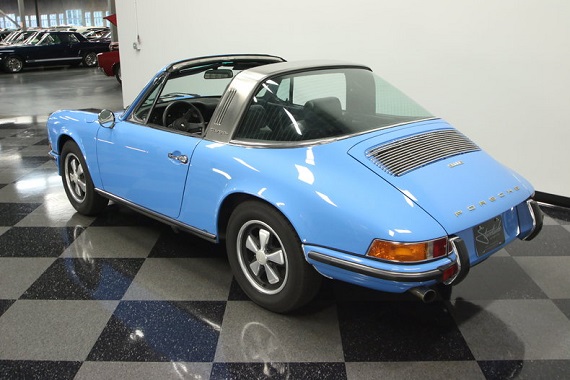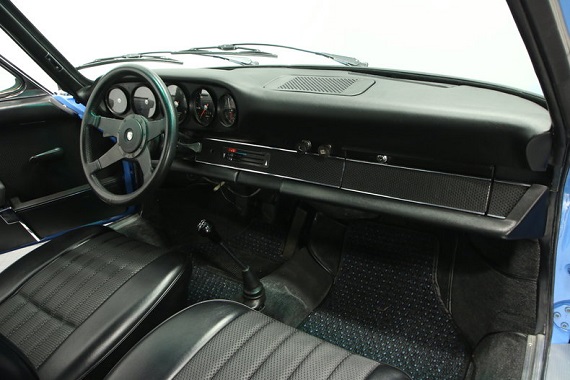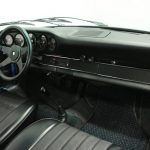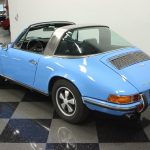This 911 was always bound to attract my attention. It’s a Targa covered in a vibrant shade of blue and it looks in very nice shape; points that immediately serve in its favor for me. It’s also a 911E, which I’ve always liked as a middle ground between the entry-level T and the very sought after 911S. Step inside and what looks like a fairly basic interior suddenly makes me pause. First, this is probably the ugliest steering wheel I’ve ever seen. No big deal really; throw a Prototipo on (or find a period-correct wheel if originality is your concern) and move along. Then I notice there’s no radio. The ad makes no mention of a radio delete. We aren’t presented with the CoA so that doesn’t help. Now I’m intrigued and want to know more. Is this just a matter of a restorer deciding to remove the radio or is there something more to this 911E?
CLICK FOR DETAILS: 1970 Porsche 911E Targa on eBay
Year: 1970
Model: 911E Targa
Engine: 2.2 liter flat-6
Transmission: 5-speed manual
Mileage: 36,646 mi
Price: $119,995 Buy It Now
This is the vintage exotic so many of us long for. A 1970 Porsche 911E Targa offers many of the delicate design touches of the first-generation 911, and then adds power to the package. So when it’s presented in an interesting and correct factory color, this is an open top dream car.
The 911’s shape is legendary, and that’s why there is so much appreciation for a car like this. The narrower bodies, tidy proportions, and elegant simplicity showcase the iconic shape in its purest form. Porsches have always been high-quality machines, and this one continues that tradition today with doors that open and close effortlessly and exacting panel gaps. We even suspect a small fortune was spent on re-spraying the factory-correct pastel blue paint. It has the kind of luster that begs for the sunshine, and that’s exactly what a Targa model is expected to do. Enthusiasts easily identify this rarer open top model by its stainless steel hoop at the B-pillar and wrap-around rear window. Chrome was still in fashion in 1970, even in Germany, so this 911 retains its slender bumper trim, polished headlight rings, bright windshield surround, and those great vents that signify this is an early 911 that wanted to stay connected to another icon, the 356. And speaking of icons, the Fuchs wheels are a true Porsche hallmark.
The great thing about the air-cooled 911 era is that the moment you climb inside, they all have a familiar feeling like a close-knit family. The driver-oriented layout is engineered to make sure everything is within easy reach. Porsche’s race-ready sensibilities means the tachometer is directly in front of the driver. The rest of the instruments surround this in their own clearly marked pods to give you a comprehensive view of what’s going on with the engine. You view all of this through an upgraded Lecarra sports steering wheel. The targa top fits snugly, and easily stores in the carpeted trunk when you want the wind-in-your-hair driving experience. And because this 911 will be open to the world, the seats, carpeting, door panels, and whole interior is looking dark and crisp to make sure everyone sees this icon at its best.
The 2.2-liter flat-six has that unmistakable tone even at idle, and so you love one that looks well maintained and fires up with ease like this one does. This car is all about getting in, turning the key, and instantly start having fun. The motor was built to be driven like a performance machine, and Porsche made sure you had the control of a five-speed manual so you were an integral part of getting every last ounce of performance out it. The 911’s spirited fully independent suspension and four-wheel disc brakes are all part of a unique sporting package that truly helped it earn its motto of, “There is no substitute.”
This car is complete right down to its toolkit. It’s an example of open air European motoring at its finest. So now is the time to fulfill the promise you made to yourself. Call today!!!
I have no answers to my questions about the radio. I suspect it’s a simple case of a past owner deciding he didn’t want the radio, removing it and replacing it with a panel. A restorer (because I’m assuming this 911 has been restored, though that is not made clear) then kept that aspect as it was.
But perhaps there’s more. I don’t know. Honestly, I’m not familiar enough with the options available at the time this 911E was in production and whether a radio delete was an option. So I’m stumped. I’ll also admit that I may be making too much of this, but I’m fairly certain just about every 911 I’ve come across from the period has had a radio. Maybe that’s wrong, but as I said above I want to know more. This either will represent a learning moment for me or this 911E will turns out to be a little more special than I first suspected. Either way, it’s certainly unique. Any ideas?
(Oh, and since I didn’t mention it: the color is awesome and it’s really, really, pretty!)
-Rob











I once owned – and should have kept for a few more years – a 1972 911 T. It was Gulf Blue, one of the “bubble gum” colours, quite similar to this one, and it too was radio-delete. No covering panel seemed to be added, so it must have been an option.
That E is really nice, but I find the price pretty high; it seems to me the P prices have reached a plateau and, in Europe at least, I’ve read that the speculation has ended, except for the cars that are really special or rare.
Ah, so radio delete is definitely a thing. Good to know, thanks. And this one too doesn’t look like there has just been a panel added. I agree with you on the price and market. This one is a bit high for an E and while the radio delete is a neat option I’m not sure it’s the type to really bring this into the “special” category where we see much higher prices. We’ll see though.